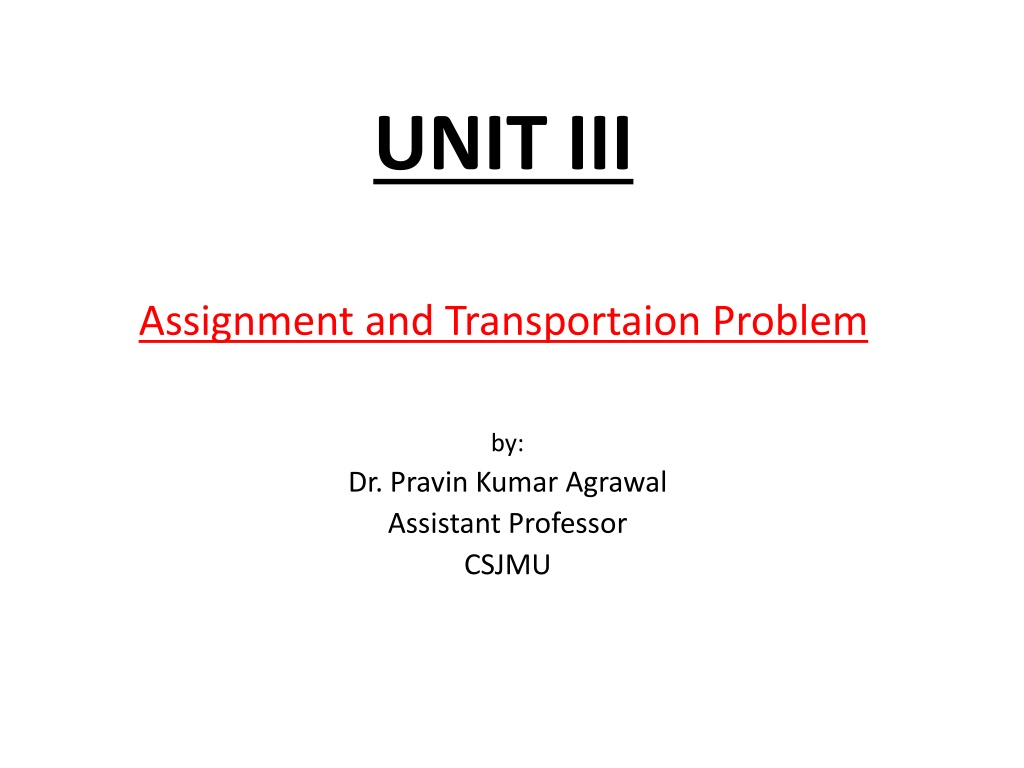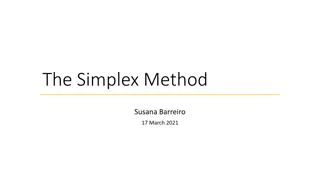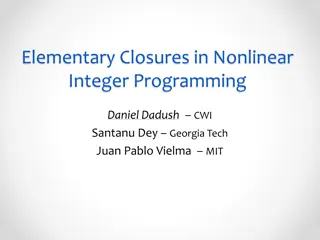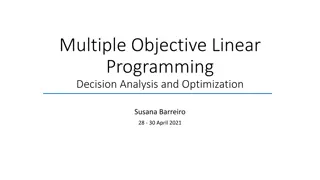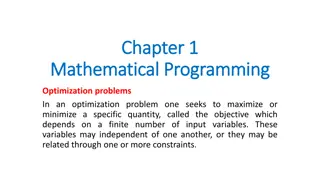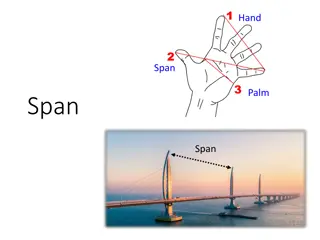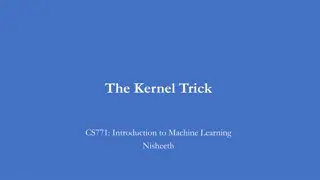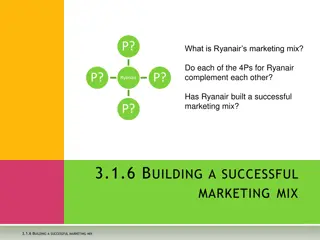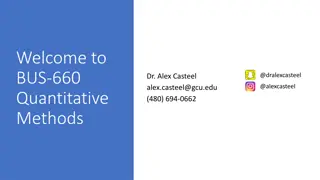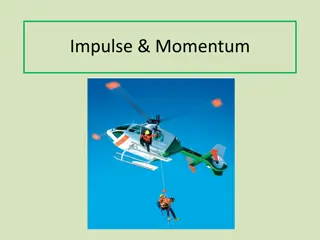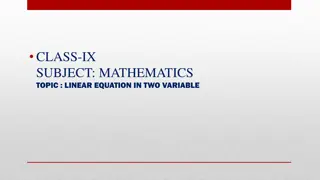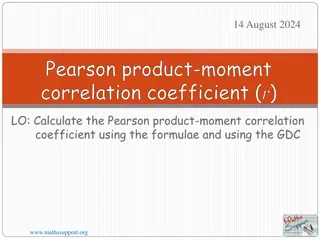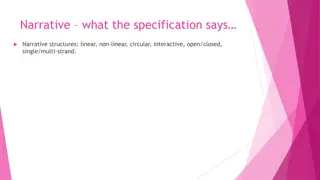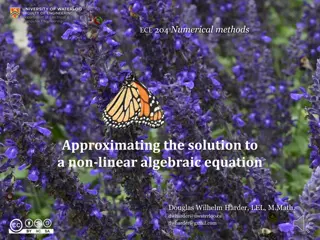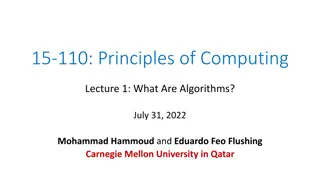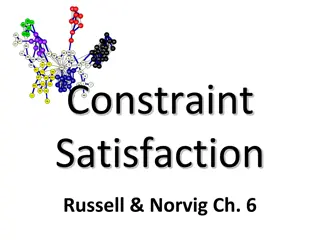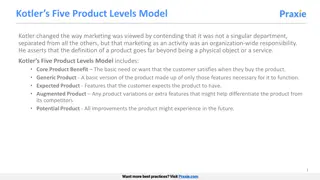Linear Programming Models for Product-Mix Problems and LP Problem Solutions
This unit covers the formulation of linear programming (LP) models for product-mix problems, including graphical and simplex methods for solving LP problems along with the concept of duality. It also delves into transportation problems, offering insights into LP problem resolution techniques.
Download Presentation

Please find below an Image/Link to download the presentation.
The content on the website is provided AS IS for your information and personal use only. It may not be sold, licensed, or shared on other websites without obtaining consent from the author. Download presentation by click this link. If you encounter any issues during the download, it is possible that the publisher has removed the file from their server.
E N D
Presentation Transcript
UNIT III Assignment and Transportaion Problem by: Dr. Pravin Kumar Agrawal Assistant Professor CSJMU
Unit II (10 L) Linear Problem formulations of LP Models for product-mix problems; graphical and simplex method of solving LP problems; duality. Programming Linear Problem programming: & Transportation Mathematical Transportation problem: Various methods of finding Initial basic feasible solution-North West Corner Method, Least Cost Method & VAM Method and optimal solution-Stepping Stone & MODI Method, Maximization Transportation Problem
Transportation Problem The transportation problem is a special type of linear programming problem where the objective is to minimise the cost of distributing a of sources or origins to a number of destinations. Because of its special structure the usual simplex method is not suitable for solving transportation problems. These problems require a special method of solution. The origin of a transportation problem is the location from which shipments are despatched. The destination of a transportation problem is the location to which shipments are transported. The unit transportation cost is the cost of transporting one unit of the consignment from an origin to a destination. product from a number
Transportation problem Cells in the transportation table that have positive allocations are called as occupied cells otherwise they are known as non-occupied cells.
The Decision Variables The variables in the Linear Programming (LP) model of the TP will hold the values for the number of units shipped from one source to a destination. The decision variables are: Xij = the size of shipment from warehouse i to outlet j , Where I = 1,2,3...m and j = 1,2,3,...n . This is a set of m X n variables
Feasible Solution (F.S.) A set of non-negative allocations xij> 0 which satisfies the row and column restrictions is known as feasible solution
Basic Feasible Solution (B.F.S.) A feasible solution to a m-origin and n- destination problem is said to be basic feasible solution if the number of positive Allocations are (m+n 1). If the number of allocations in a basic feasible solutions are less than (m+n 1), it is called degenerate basic feasible solution (DBFS) (Otherwise non-degenerate).
Optimal Solution A feasible solution (not necessarily basic) is said to be optimal if it minimizes the total transportation cost.
Allocation The number of units of items transported from a source to a destination which is recorded in a cell in the transportation tableau.
Balanced Transportation Problems Cases where the total supply is equal to the total demand.
Unbalanced Transportation Problems Cases where the total supply is not equal to the total demand. When the supply is higher than the demand, a dummy destination is introduced in the equation to make it equal to the supply (with shipping costs of rs. 0); the excess supply is assumed to go to inventory. On the other hand, when the demand is higher than the supply, a dummy source is introduced in the equation to make it equal to the demand (in these cases there is usually a penalty cost associated for not fulfilling the demand).
Unbalanced Transportation Problems When the number of positive allocations (values of decision variable) at any stage of the feasible solution is less than the required number (rows+columns-1) i.e number of independent constraints solution is said to be degenerate, otherwise non-degenerate. equations, the
General Mathematical Model of Transportation Problem
Let . ..............smhaving ai( i = 1,2,......m) units of supplies respectively to be transported among n destinations d1, d2 dnwith bj( j = 1,2 ..n) units of requirements respectively. there be m sources of supply s1, s2, Let cijbe the cost for shipping one unit of the commodity from source i, to destination j for each route. If xijrepresents the units shipped per route from source i, to destination j, then the problem is to determine the transportation minimizes the total transportation cost of satisfying supply and demand conditions. schedule which
Existence of a feasible solution A necessary and sufficient condition for the existence of a feasible transpiration problem is solution to a That is the total supply must be equal to the total demand.
Existence of a feasible solution In this problem there are m + n constraints, one for each source of supply and distinction and m X n variables. Any feasible solution for a transportation problem must have exactly (m+n-1) non negative (allocations) xij Satisfying the rim conditions. basic variables
Methods to Solve To find the initial basic feasible solution there are three methods: North West Corner Cell Method. Least Call Cell Method. Vogel s Approximation Method (VAM).
Methods to Solve In the above table D1, D2, D3 and D4 are the destinations where the products/goods are to be delivered sources S1, S2, S3 and S4. Siis the supply from the source Oi. djis the demand of the destination Dj. Cijis the cost when the product is delivered from source Sito destination Dj. from different
Steps for North-West Corner Method Allocate the maximum amount allowable by the supply and demand constraints to the variable X11 (i.e. the cell in the top left corner of the transportation tableau). If a column (or row) is satisfied, cross it out. The remaining decision variables in that column (or row) are non-basic and are set equal to zero. If a row and column are satisfied simultaneously, cross only one out (it does not matter which). Adjust supply and demand for the non-crossed out rows and columns. Allocate the maximum feasible amount to the first available non-crossed out element in the next column (or row). When exactly one row or column is left, all the remaining variables are basic and are assigned the only feasible allocation.
Steps for North-West Corner Method Start with the cell at the upper left (north - west) corner of the transportation matrix and allocate commodity equal to the minimum of the rim values for the first row and first coloumn i.e min (a1, b1)
Steps for North-West Corner Method If allocation made in step 1 is equal to the supply available at first source (a1, in first row) then move vertically down to the cell (2,1) in the second row and first column. Apply step I again, for next allocation. If allocation made in step I is equal to the demand of the first destination (b1 in first column), then move horizontally to the cell (1,2) in the first row and second coloumn. Applly step I again for next allocation. If a1= b1 allocate X11 = a1 or b1 and move diagonally to the cell (2,2)
Steps for North-West Corner Method Continue the process step by step till an allocation is made in the south east corner cell of the transportation table.
Numerical 1 A company has three production facilities S1, S2 and S3 and the production capacity of 7, 9 and 18 units (in 100s) per week of a product, respectively. These units are to be shipped to four warehouses D1, D2, D3 and D4 with requirement of 5,6,7 and 14 units (in 100s) per week respectively. The transportation cost per unit in rupees between factories to warehouses are given in the table below:
Numerical D1 D2 D3 D4 Capacity/ Supply 7 S1 = 19 30 50 10 warehou e S2 70 30 40 60 9 S3 40 8 70 20 18 Demand 5 8 7 14 34 Formulate this problem as an LP Model to minimize the total transportation cost.
Numerical D1 D2 D3 D4 Capacity/ Supply 2 S1 = 19 30 50 10 warehou e 5 S2 70 30 40 60 9 S3 40 8 70 20 18 Demand 5 8 7 14 34 Formulate this problem as an LP Model to minimize the total transportation cost.
Numerical D1 D2 D3 D4 Capacity/ Supply 2 S1 = 19 30 50 10 warehou e 2 5 S2 70 30 40 60 9 S3 40 8 70 20 18 Demand 5 6 7 14 34 Formulate this problem as an LP Model to minimize the total transportation cost.
Numerical D1 D2 D3 D4 Capacity/ Supply 2 S1 = 19 30 50 10 warehou e 2 5 S2 70 30 40 60 3 3 6 S3 40 8 70 20 18 Demand 5 6 4 14 34 Formulate this problem as an LP Model to minimize the total transportation cost.
Numerical D1 D2 D3 D4 Capacity/ Supply 2 S1 = 19 30 50 10 warehou e 2 5 S2 70 30 40 60 3 3 6 S3 40 8 70 20 18 14 4 Demand 5 6 4 14 34 Total Transportation Cost = 19X5 + 30 X2 + 30X6 + 40X3 + 70X4 +14X20 =
N Numerical W E North West Corner Method D1 D2 D3 D4 Capacity S1 19 30 50 10 2 2 S2 70 30 40 60 9 S3 40 8 70 20 18 Demand 3 8 7 14 34 Formulate this problem as an LP Model to minimize the total transportation cost.
N Numerical W E North West Corner Method D1 D2 D3 D4 Capacity S1 19 30 50 10 2 2 5 S2 70 30 40 60 9 S3 40 8 70 20 18 Demand 5 7 14 34 6 Formulate this problem as an LP Model to minimize the total transportation cost.
N Numerical W E North West Corner Method D1 D2 D3 D4 Capacity S1 19 30 50 10 2 2 5 S2 70 30 40 60 3 6 S3 40 8 70 20 18 Demand 5 7 14 34 6 Formulate this problem as an LP Model to minimize the total transportation cost.
N Numerical W E North West Corner Method D1 D2 D3 D4 Capacity S1 19 30 50 10 2 2 5 S2 70 30 40 60 3 6 3 S3 40 8 70 20 18 Demand 5 4 14 34 6 Formulate this problem as an LP Model to minimize the total transportation cost.
N Numerical W E North West Corner Method D1 D2 D3 D4 Capacity S1 19 30 50 10 2 2 5 S2 70 30 40 60 3 6 3 S3 40 8 70 20 18 14 4 Demand 5 4 14 34 6 ==19X5 + 30X2 +30X6 + 40X3 + 70X4 + 14X20 = 95+60+180+120+280+280 = Rs. 1015 Formulate this problem as an LP Model to minimize the total transportation cost.
Numerical 1 D1 =lucknow D2=baliya D3=kanpur D4=delhi Capacity S1 19 30 50 10 2 S2 70 30 40 60 3 S3 40 8 70 20 18 Demand 6 4 14 34 5 Formulate this problem as an LP Model to minimize the total transporation cost.
Solution D1 D2 D3 D4 Capacity S1 19 50 10 7 30 5 S2 70 30 40 60 9 S3 40 8 70 20 18 Demand 5 8 7 14 34 Formulate this problem as an LP Model to minimize the total transporation cost.
Solution D1 D2 D3 D4 Capacity S1 19 50 10 7 30 5 S2 70 30 40 60 9 S3 40 8 70 20 18 Demand 5 8 7 14 34 Formulate this problem as an LP Model to minimize the total transporation cost.
Solution The cell (S1, D1) is the north west corner cell in the given transpiration table. The rim values for row S1 and column D1 are compared. The smaller of the two, i.e. 5 is assigned as the first allocation. This means that 5 units of a commodity are to be transported from source S1 to destination D1. However this allocation leaves a supply of 7-5 = 2 units of commodity at S1.
Solution D1 D2 D3 D4 Capacity S1 19 30 50 10 7 2 5 S2 70 30 40 60 9 6 S3 40 8 70 20 18 Demand 5 8 7 14 34 Formulate this problem as an LP Model to minimize the total transporation cost.
Solution D1 D2 D3 D4 Capacity S1 19 30 50 10 7 2 5 S2 70 30 40 60 9 6 3 S3 40 8 70 20 18 Demand 5 8 7 14 34 Formulate this problem as an LP Model to minimize the total transporation cost.
Solution D1 D2 D3 D4 Capacity S1 19 30 50 10 7 2 5 S2 70 30 40 60 9 6 3 S3 40 8 70 20 18 4 14 Demand 5 8 7 14 34
Solution The cell (S1, D1) is the north west corner cell in the given transpiration table. The rim values for row S1 and column D1 are compared. The smaller of the two, i.e. 5 is assigned as the first allocation. This means that 5 units of a commodity are to be transported from source S1 to destination D1. However this allocation leaves a supply of 7-5 = 2 units of commodity at S1.
Solution Move horizontally and allocate as much as possible to cell (S1, d2). The rim values for S1 is 2 and coloumn D2 is 8. The smaller of the two i.e 2 is placed in the cell. Proceeding to row S2 since the demand of D1 has been met nothing further can be allocated to D1. The unfulfilled demand of D2 is now 8-2 = 6 units. This can be fulfilled by S2 with capacity of 9 units. So 6 units are allocated to cell (S2, D2). The demand of D2 is now satisfied and a balance of 9 6 =3 units remains with S2.
Solution Move horizontally and vertically in the same manner. This should be done because successive demand and supply are met. Ensure that solution is feasible , the number of positive allocation is equal to m+n-1 = 3+4- 1 = 6. Total cost = =5X19+ 2X30 + 6X30 + 3X40 + 4X70 + 14X 20 = Rs. 1015
Assignment 1 D1 D2=baliya D3=kanpur D4=delhi Supply =lucknow S1 2 3 11 7 6 S2 1 0 6 1 1 S3 5 8 15 9 10 Require ments 5 3 2 17 7 Formulate this problem as an LP Model to minimize the total transportation cost by North West Corner Method.
Assignment 1 D1 D2=baliya D3=kanpur D4=delhi Supply =lucknow S1 2 3 11 7 6 6 S2 1 0 6 1 1 1 S3 5 8 15 9 10 5 3 2 Require ments 5 3 2 17 7 Formulate this problem as an LP Model to minimize the total transportation cost by North West Corner Method.
